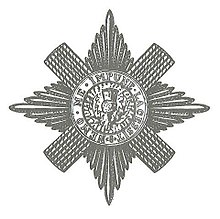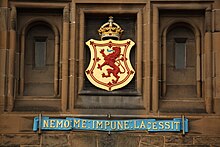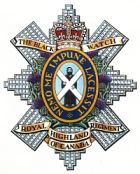Nemo me impune lacessit


Nemo me impune lacessit (Latin for 'No one provokes me with impunity') is the national motto of Scotland.[1][2][3] It also served as the national motto of the historic Kingdom of Scotland prior to the Treaty of Union 1707.[4]
The motto was the Latin motto of the Royal Stuart dynasty of Scotland from at least the reign of James VI when it appeared on the reverse side of merk coins minted in 1578 and 1580.[5][6] It is the adopted motto of the Order of the Thistle and of three Scottish regiments of the British Army.[7]
The motto also appears, in conjunction with the collar of the Order of the Thistle, in later versions of the royal coat of arms of the Kingdom of Scotland and subsequently in the version of the royal coat of arms of the United Kingdom used in Scotland. It has been loosely rendered in Scots as Wha daur meddle wi' me?[8] (in Scottish Gaelic Cha togar m' fhearg gun dìoladh, pronounced [xa ˈt̪okəɾ ˈmɛɾak kuɲ ˈtʲiəl̪ˠəɣ] ). It more or less translates as 'No one can harm me without (detrimental) consequence' or 'Whatever harm comes to me, shall be returned'.
Possible origin of the motto
[edit]
According to legend, the "guardian thistle" (see Cirsium vulgare) played a vital part in Alexander III, King of Scots' defence of the Kingdom of Scotland against a night-time raiding party of Vikings under King Haakon IV of Norway, prior to the Battle of Largs (1263): one or more raiders let out a yell of pain when stepping on a prickly thistle, thus alerting the Scots.[9] In the motto "No one harasses me with impunity" (Latin: Nemo me impune lacessit), "me" was therefore originally the thistle itself, but by extension now refers to the Scottish regiments which have adopted it.
The modern form of the motto was used by Francesco I, Duke of Milan and had been used in Britain on the colours of the Scottish Royalist officer John Urry during the English Civil War.[10] It was also used by the Parliamentarian propagandist Marchamont Nedham as the motto for his newsletters.[11]
Another traditional source appears in the form of a Scots proverb, "Ye maunna tramp on the Scotch thistle, laddie", this being immortalised in marble by Glasgow monumental sculptors James Gibson & Co. for the Kelvingrove International Exhibition of 1888.[12] The phrase "Wha daur meddle wi' me?" also appears in a traditional border ballad entitled "Little Jock Elliot",[13] which recalls the exploits of a 16th-century Border Reiver ("John Elliot of the Park"), with particular reference to an infamous encounter in the summer of 1566 with James Hepburn, 4th Earl of Bothwell,[14] the third husband of Mary, Queen of Scots.
The French city of Nancy has a similar motto, Non inultus premor ("I cannot be touched unavenged"), also a reference to the thistle, which is the symbol of the region of Lorraine.
Present and historical use of the motto
[edit]In the British Isles and Commonwealth
[edit]
The motto of the Most Ancient and Most Noble Order of the Thistle, the Scottish chivalrous order, is also that of the British Army regiments The Royal Regiment of Scotland, Scots Guards and Royal Scots Dragoon Guards. It was also the motto of several former units of the British Army, including the Royal Scots, Royal Scots Greys, Royal Highland Fusiliers and Black Watch, some of which went on to be amalgamated to form the Royal Regiment of Scotland in 2006. The motto is also that of the Royal Company of Archers and has been displayed upon the unit's second standard since 1713, following the grant of a Royal charter by Queen Anne.
During the reign of Charles II, the motto, appearing on a scroll under the shield and overlying the compartment, was added to the Royal coat of arms of Scotland, as displayed in relief above the entrance to Holyrood Palace. Since 1707 it has appeared in the Scottish version of the arms of British Monarchs, including the present Royal coat of arms of the United Kingdom used in Scotland. The motto appears in conjunction with the collar of the Order of the Thistle, which is placed around the shield. (The collar of the order appears in earlier versions of the Royal coat of arms of Scotland, but without the order motto.)
The motto of the Order of the Thistle (Nemo me impune lacessit) should not be confused with the motto of the Royal arms (In Defens), which appears on an escroll above the crest in the tradition of Scottish heraldry[15] (In Defens being an abbreviated form of the full motto In My Defens God Me Defend).[16] Nemo me impune lacessit is displayed prominently above the Gatehouse entrance added to Edinburgh Castle in 1888.
Armed forces units elsewhere have also adopted this historic motto. In Australia, members of Heavy Weapons Platoon (DFSW) of the 3rd battalion (PARA) Royal Australian Regiment proudly use this motto as a symbol of platoon brotherhood and bonds forged in service together, the motto was also used by the Victoria Scottish Regiment, which subsequently became 5th Battalion Royal Victoria Regiment (RVR) which now forms one of the rifle companies of the RVR. (The motto is also used by the RVR Pipes and Drums Association). The Black Watch (Royal Highland Regiment) of Canada, a reserve infantry regiment of the Canadian Forces, also bears this motto (the motto appearing upon the regimental cap badge).
The motto is also that of the Cape Town Highlanders Regiment, a reserve mechanised infantry unit of South African Army.
The Caledonian Railway used the motto as part of its crest, until "grouped" into the London, Midland and Scottish railway in 1923.
The motto (with the verb in the future tense [lacesset]: "Nemo Me Impune Lacesset") appears as a reverse inscription on the Scottish "Bawbee" (6 pence) coin of King Charles II surrounding a crowned thistle. Examples exist for 1677, 1678 and 1679. The coin is scarce but not considered rare. This coin is of copper, and was later revalued as a half penny.
The motto appears as an inscription on the rim of both the 1984 (and 1989) "Thistle and royal diadem" and the 1994 (and 1999) "Lion rampant" designs of the "Scottish" themed editions of the British one pound coin,[17] and again on the rim of one of two new "floral" designs for 2014.
Union College, University of Queensland, Australia, also adopted the motto.
The motto also appears on the back collar of Edinburgh Rugby official kit.
In continental Europe
[edit]In Belgium, the 1st Squadron of the Belgian Air Force bears the motto.
The motto was also used by the Italian noble family Malacrida, of Como.[18]
Wilhelm II, German Emperor used the motto in a telegram to Foreign Minister Bernhard von Bülow on 7 November 1897 following the Kiautschou Bay concession, arguing that Chinese aggression towards Catholic missionaries would no longer be tolerated, and would be met with swift military action.
The motto also appears above the entrance of a gate in Gent (see nl:Citadel van Gent).
It was the motto of the Swedish Tre Kronor-class cruiser HSwMS Göta Lejon.
It's the motto of Smålands Nation in Uppsala.
In North America
[edit]
The 1st Battalion, 24th Marines of the United States Marine Corps uses the phrase as its motto.
It is also referred to in the Edgar Allan Poe story "The Cask of Amontillado" (Poe was adopted by a Scottish merchant), and in Stanisław Lem's Fiasco.[19]
The motto also appears (with the verb in the future tense: Nemo Me Impune Lacesset) above an American timber rattlesnake on a 1778 $20 bill from Georgia as an early example of the colonial use of the coiled rattlesnake symbol, which later became famous on the Gadsden flag. The phrase also occasionally appears on mourning bands worn over the badges of law enforcement officers in the United States.[20][self-published source?]
Nemo me impune lacessit is the motto of Dartmouth College's independent conservative newspaper, The Dartmouth Review.[21]
The motto also appears on the crest of the Grand National Curling Club.
The motto is adopted by the eponymous heroine of Fran Ross's 1974 novel, Oreo, republished in 2000 by Northeastern University Press.[22]
In India
[edit]On 10 December 1992, addressing Gentleman Cadets at the Indian Military Academy, India's Field Marshal Sam Manekshaw conveyed the motto from a regiment he had served in Scotland, first conveying the Latin form, "Nemo me impune lacessit" and then translating it for the GCs:[23]
... in soldier's language, "If my enemy punches me on my nose I shall black both his eyes and make him swallow his teeth. Let that be your motto. No one must provoke you with impunity."
In fiction
[edit]- In the short story "The Cask of Amontillado" by Edgar Allan Poe, Nemo me impune lacessit is the motto on the family coat of arms of the character Montresor.
- In the 1986 science fiction novel "Fiasco" by Stanislaw Lem, Nemo me impune lacessit is quoted on several occasions in response to hostile acts during attempted contacts with an alien civilisation
- In the 1994 novel Mortal Causes by Ian Rankin, the motto is a clue in solving a young man's murder.
- In the miniature wargame Warhammer 40,000, the motto is used by the Raven Guard
- In the miniature wargame Battletech, the motto is used by the Black Watch, the elite guard of the Star League Defense Force.
See also
[edit]- Knights of Cardone
- Noli me tangere – "touch me not"
References
[edit]- ^ "Scotland's Motto". www.nytimes.com. The New York Times. Retrieved 16 February 2024.
Scotland's Motto - Nemo me input lacessit - Thistle. Quae nocent docent. - Volunteer. Or, freely translated, No one injures me with impunity -- Thistle. Things which injure instruct - Volunteer
- ^ Blaikie, W. Garden (1894). The Peasantry of Scotland. pp. 327–336. Retrieved 17 February 2024.
"The Scot Abroad" was a sturdy customer, notwithstanding his weaknesses and prejudices, and bore the stamp of the national motto, Nemo me impune lacessit.
- ^ Mengel, Elias F. (1973). "The Dunciad Illustrations". Eighteenth-Century Studies. 7 (2): 161–178. doi:10.2307/3031652. ISSN 0013-2586.
The motto, Nemo me impune lacessit, is not only that of Scotland but also that of the Order of the Thistle, the distinctively Scottish order of knighthood.
- ^ "Scottish fact of the day: Nemo me impune lacessit | The Scotsman".
- ^ Numismatology article in The Popular Encyclopedia. 1841. Retrieved 17 August 2014.
- ^ Coin from reign of James VI, retrieved 17 August 2014
- ^ "A reputation forged in heat of war – Telegraph". Archived from the original on 25 November 2004.
- ^ "the motto 'Nemo me impune lacessit' (No one provokes me with impunity – or, in Old Scots, 'Wha daur meddle wi' me'.)" Archived 6 January 2011 at the Wayback Machine, Scottish Field magazine, retrieved 2 October 2009
- ^ "The Thistle - National Emblem of Scotland". Historic UK. Retrieved 8 June 2016.
- ^ Ian Gentles, "The Iconography of Revolution: England 1642–1649", in Soldiers, Writers and Statesmen of the English Revolution, edited by Ian Gentles, John Morrill & Blair Worden, pp. 91–113 (Cambridge: Cambridge University Press, 1998) p. 100.
- ^ Ian Gentles, The Iconography of Revolution: England 1642–1649, p. 100, note 34.
- ^ Gardner, Tim. "Glasgow - City of Sculpture, by Gary Nisbet". Glasgowsculpture.com. Retrieved 29 July 2014.
- ^ "jedburgh-online.org.uk". www.jedburgh-online.org.uk. Archived from the original on 14 May 2008.
- ^ "Lord Bothwell". Lord Bothwell. Archived from the original on 12 April 2013. Retrieved 29 July 2014.
- ^ "International Civic Heraldry". Ngw.nl. Retrieved 29 July 2014.
- ^ "Image". Retrieved 29 July 2014.
- ^ "£1 Coin | The Royal Mint". www.royalmint.com.
- ^ Cut Armorial Bookplate on: John Gother, "The Key of Heaven or, A Posey on Prayers, Selected from Catholic Authors" (Keating, Brown and Keating, 1815).
- ^ Lem, Stanislaw (1986). Fiasco. Harcourt Brace Jovanovich. pp. 222, 227, 273, 290. ISBN 0-15-630630-1.
- ^ "Funeral Badge" (JPG). Retrieved 1 April 2009.
- ^ "The Dartmouth Review". Dartreview.com. Retrieved 29 July 2014.
- ^ Ross, Fran. Oreo. Northwestern University Press.
- ^ Singh 2007, p. 201.
Bibliography
[edit]- Singh, Brigadier M. P. (2007). History of the Indian Military Academy. Ludhiana: Unistar Books. ISBN 9788189899561.
External links
[edit] Media related to Nemo me impune lacessit at Wikimedia Commons
Media related to Nemo me impune lacessit at Wikimedia Commons- Scottish coins

